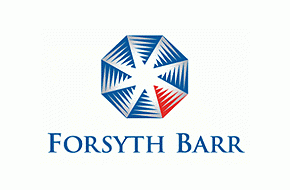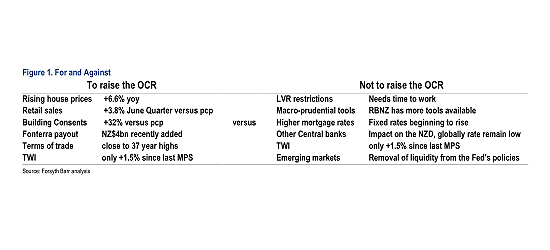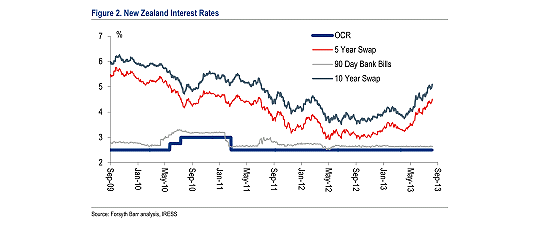
Content supplied by Forsyth Barr
The following is a summary of the key events impacting fixed income markets over the past week.
The first week of September may begin slowly with the US on holiday, however it should begin to pick up pace with central bank meetings in Australia, Japan, Europe and the UK. The week closes with key US non-farm payrolls data for August and the subsequent US unemployment rate.
Eyes firmly on the RBNZ
Central bank meetings and the US non-farm payroll data was the key focus of last week with the attention now shifting to Thursday’s Reserve Bank of New Zealand’s (RBNZ) Monetary Policy Statement (MPS). The market still remains at odds with the RBNZ in terms of the timing of a hike in the Official Cash Rate. What clues will the RBNZ provide?
US Non-farm payrolls data disappoints but yields rise over the week
In what has become such a highly anticipated economic release, the US non-farm payrolls and subsequent US unemployment rate was largely disappointing. 169,000 jobs were created in August, fewer than the 180,000 expected, however the unemployment rate fell to 7.3% as only 63% of Americans are in the workforce – the lowest participation rate in 35 years. There was also some hefty revisions (lower) to previous month’s employment data.
The yields on longer-dated bonds continued to rise and hence the impact on the long-end of the New Zealand curve was also evident. The 2023 NZGB is +155bp higher than its lows in May 2013 with the 10-year swap rate risng +13bp last week.
The combination of Thursday’s MPS along with the US Federal Reserve’s meeting a week later may be definitive with many picking “tapering” to be announced by the Fed. Despite the softer economic data of late the unemployment rate is heading lower towards the key 7% level and any deviation away from those previously announced targets may cause some issues in the market.
Inflation–indexed NZGB
The New Zealand Debt Management Office (DMO) received strong demand for its auction of NZ$300m of inflation-indexed New Zealand Government bonds. The DMO received over NZ$700m of bids for the 2025 maturity bonds. This type of demand may encourage the DMO to issue of another inflation-indexed NZGB which was signalled back in June. The new bond is expected to have a 2030 maturity.
NZ corporate bond yields to hit 5%?
The yield on the ANZ Investment Grade Bond Index once again touched its recent highs, falling just short of 5.00%. The yield rose +9bp last week to end the week at 4.97%, its highest level since March 2012.
Offshore it was relatively quiet with credit markets globally quite flat over the week. Australia narrowed by -3bp with the US also -2bp tighter. Europe however were +1bp wider over the course of the week.
Status Quo for the ECB and BoE
The European Central Bank (ECB) President, Mario Draghi reiterated that interest rate were to remain at present or lower levels for an extended period of time. The market had been expecting no change but it had also been expecting a bit more from the ECB given some recent positive data in the region.
The Bank of England followed suit, however it did not provide any forward guidance at this meeting despite interest rates moving higher of late. The 10 year bond rate has risen +61bp since the new Governor provided forward guidance and with no comment against rising interest rates, the ‘no comment’ was seen as a positive.
Monetary Policy Statement (Thursday, 12 September 2013, 9:00am)
The Reserve Bank of New Zealand (RBNZ) will deliver its eagerly awaited Monetary Policy Statement (MPS) on Thursday. Market consensus around the timing of a possible hike in the Official Cash Rate (OCR) has shifted in recent weeks post the announcement of the loan-to-value (LVR) restrictions.
Prior to the 20 August LVR announcement from the Governor, Graeme Wheeler, the market had brought forward from a full 25bp hike in March 2014 to January. However, the hawkishness has waned somewhat with many believing that the RBNZ may wait for some definitive results from the LVR implementation.
Another reason for the RBNZ to wait is the impact of raising the OCR on the NZD. No other central bank in the world is close to raising interest rates and New Zealand’s OCR is already considerably higher than other sovereigns benchmark interest rates. On a TWI basis the NZD is +2.3% higher than when the RBNZ delivered its last MPS on 13 June.
The case to raise the OCR
Despite what is happening globally, the domestic economy is very strong with retail sales, building consents and rising house prices all pointing to a rise in the OCR. More importantly, in the RBNZ’s September inflation expectations survey, one-year ahead inflation expectations rose +38bp to 1.9% with two-year ahead expectations increasing +30bp to 2.36%.
Most economists still expect a hike in the OCR at the March 2014 RBNZ meeting despite the impact (or further implementations) of the macro-prudential tools. The impact of such tools are very difficult to gauge given the interesting dynamics that are unfolding. We have seen over the last week a divergence in mortgage pricing with more fees and higher mortgage rates for the ‘high risk’, over 80% LVR borrowers and lower pricing for ‘low risk’, lower than 80% borrowers.
All of the LVR scenarios may well be irrelevant if inflation looks to be on the rise on the back of a strong domestic economy. It may well be a case of the RBNZ being forced to raise the OCR more aggressively than they initially envisaged should they choose to wait for a favourable outcome from the macro-prudential tools.


Corporate / Credit news
Allied Farmers (ALF) announced that its subsidiary Allied Farmers Rural is proposing to undertake a bond issue. The August 2014 maturing bonds will pay 12% with ALF looking to raise up to a maximum NZ$1m. The bonds will also come with 58 options to buy shares for every 10 bonds held.
Auckland Council said it had borrowed NZ$300m via a 15-year bond issued to Norwegian institutional investors. The bonds pricing was similar to Auckland Council’s funding in New Zealand at 113bp over the 90 day bank bill.
Fonterra (FCG) had its AA- credit rating affirmed by Fitch Ratings.
The Local Government Funding Agency (LGFA) will hold tender number 15 on Wednesday 11 September. The LGFA will look to raise NZ$115m across four maturities: NZ$10m via April 2015s, NZ$15m via December 2017s, NZ$30m via March 2019s and NZ$60m from May 2021s.
Moody’s downgraded the subordinated debt ratings of Basel II compliant securities of eight Australian banks. Moody’s removed the uplift support in wake of the recent trend to impose losses on junior ranking securities when a bank gets into a stressed situation.
The NZX released its shareholder metrics for August. It was another month of declines for the debt market with total listed debt issuance declining by -12.7% year-on-year. The total number of trades also declined by -14.3% year-on-year with the value of those trades falling -10.1%.
Westpac (WBC) launched a five-year fixed rate senior bond issue. The issue margin is expected to be around 100bp to 105bp. The offer closes on 12 September.
---------------------------------------------------------------------------------------------------
Disclosures and Disclaimers:
Disclosure: The comments in this publication are for general information purposes only. This publication is not intended to constitute investment advice under the Securities Markets Act 1988. If you wish to receive specific investment advice, please contact your Investment Advisor. Forsyth Barr Limited and its related companies (and their respective officers, agents and employees) may own or have an interest in securities or other products referred to in this publication, and may be directors or officers of, or provide investment banking services to, the issuer of those securities or products, and may receive fees for acting in any such capacity in relation to that issuer. Further, they may buy or sell securities as principal or agent, and as such may undertake transactions that are not consistent with any recommendations contained in this publication. Forsyth Barr Limited and its related companies (and their respective officers, agents and employees) confirms no inducement has been accepted from the researched/recommended entity, whether pecuniary or otherwise, in connection with making any recommendation contained in this publication or on our website.
Analyst Disclosure Statement: In preparing this publication the analyst(s) may or may not have a threshold interest in the securities mentioned in this publication. A threshold interest is defined as being a holder of more than $50,000 or 1% of the securities on issue, whichever is the lesser. In preparing this publication non-financial assistance may have been provided by the entity being researched. A disclosure statement is available on request and is free of charge.
Disclaimer: This publication has been prepared in good faith based on information obtained from sources believed to be reliable and accurate. However, that information has not been independently verified or investigated by Forsyth Barr Limited. Accordingly, Forsyth Barr Limited: (a) does not make any representation or warranty (express or implied) that the information is accurate, complete or current; and (b) excludes and disclaims (to the maximum extent permitted by law) any liability for any loss which may be incurred by any person as a result of that information being inaccurate or incomplete in any way or for any reason. The information, analyses and recommendations contained in this publication are confidential to the intended recipients and are statements of opinion only. They have been prepared for general information purposes and whilst every care has been taken in their preparation, no warranty or representation is given (express or implied) as to their accuracy or completeness. Nothing in this publication should be construed as a solicitation to buy or sell any security or other product, or to engage in or refrain from doing so or engaging in any other transaction. This publication should not be used as a substitute for specific advice. This publication is intended to provide general securities advice only, and has been prepared without taking account of your objectives, financial situation or needs, and therefore prior to acting on any information, analysis or recommendation contained in this publication, you should seek advice from your usual Investment Advisor. Forsyth Barr Limited and its related companies (and their respective officers, agents and employees) will not be liable for any loss whatsoever suffered by any person relying upon any such information, analysis or recommendation. This publication is not intended to be distributed or made available to any person in any jurisdiction where doing so would constitute a breach of any applicable laws or regulations.
We welcome your comments below. If you are not already registered, please register to comment
Remember we welcome robust, respectful and insightful debate. We don't welcome abusive or defamatory comments and will de-register those repeatedly making such comments. Our current comment policy is here.